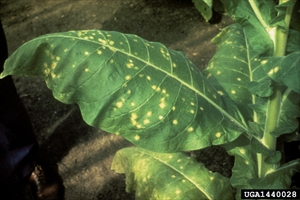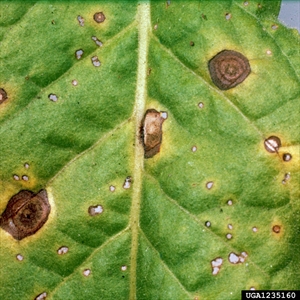Tobacco frog-eye leaf spot
Pacific Pests, Pathogens, Weeds & Pesticides - Online edition
Pacific Pests, Pathogens, Weeds & Pesticides
Tobacco frog-eye leaf spot (304)
Cercospora nicotianae
Asia, Africa, North (Hawaii) and South America, the Caribbean, Europe (restricted), Oceania. It is recorded on tobacco from Australia, Federated States of Micronesia, Fiji1, New Caledonia, Palau, Papua New Guinea, Solomon Islands, Tonga, and Vanuatu.
Tobacco, and other members of the potato (Solanum) family, tomato, eggplant, and weeds.
A common fungal disease wherever tobacco is grown, developing in the nursery (plant bed), field or barn after harvest. Spots, circular 2-15 mm diameter, brown, grey or tan, with dark borders (Photo 1). The centre of the spots becomes papery. Tiny black structures can sometimes be seen in the centres of the spots; these are groups of stalks and their spores (Photo 2).
The spots are mainly on the lower mature leaves at first, moving up the plant as the season advances. The spots continue to develop after harvest on the cured leaves.
Spread is from airborne or soilborne spores. There is a possibility that the spores are seedborne, too. Survival between crops occurs in trash from the harvested crop, on other related crops and weeds. The disease is worse in hot, humid weather.
A disease of minor importance. Its impact is greatest in Central America, West Africa and South Asia. In Central America, it is more important in shade-grown cigar varieties. The fungal infections lower the quality of the tobacco smoke, reducing some ingredients (alkaloid, sugar and phenol) and increasing others (e.g., nitrogen).
Look for the circular brown spots, 2-15 mm diameter, with white or pale brown centres, and dark margins.
CULTURAL CONTROL
Before planting:
- Remove volunteer plants of tobacco and others in the Solanum family before field planting.
- Check plants in the nursery and make sure transplants are free from the disease.
- Avoid overlapping crops, preventing spores from older crops infecting newer ones. If not possible, then plant newer crops far from those established already
During growth:
- Weed. Remove weeds, especially those related to tobacco in the potato family.
- Do not add excessive amounts of nitrogen fertilizer as this increases the susceptibility of leaves. The correct balance between P, K and N is important, and soil analyses are required to determine this.
- If practical, and where numbers of plants are small, prune infected leaves as soon as they are seen.
- Avoid overhead irrigation as water on the leaves promotes spore germination and infection; use trickle tape application of water in preference.
After harvest:
- Collect and burn or bury trash after harvest, including all the stalks and roots.
- Practice crop rotation. Do not grow tobacco for more than 2 years on the same land.
RESISTANT VARIETIES
There are resistant varieties, with resistance transferred from related species.
CHEMICAL CONTROL
If fungicides are required, use mancozeb, copper or chlorothalonil.
____________________
When using a pesticide, always wear protective clothing and follow the instructions on the product label, such as dosage, timing of application, and pre-harvest interval. Recommendations will vary with the crop and system of cultivation. Expert advice on the most appropriate pesticide to use should always be sought from local agricultural authorities.
AUTHORS Grahame Jackson & Eric McKenzie
1Information from Graham KM (1971) Plant diseases of Fiji, HMSO, London; and from CABI (2019) Cercospora nicotianae (frog-eye leaf spot of tobacco). Crop Protection Compendium. (https://www.cabi.org/cpc/datasheet/12251). Photo 1 R.J. Reynolds Tobacco Company Slide Set, R.J. Reynolds Tobacco Company, Bugwood.org. Photo 2 Clemson University - USDA Cooperative Extension Slide Series, Bugwood.org.
Produced with support from the Australian Centre for International Agricultural Research under project PC/2010/090: Strengthening integrated crop management research in the Pacific Islands in support of sustainable intensification of high-value crop production, implemented by the University of Queensland and the Secretariat of the Pacific Community.





